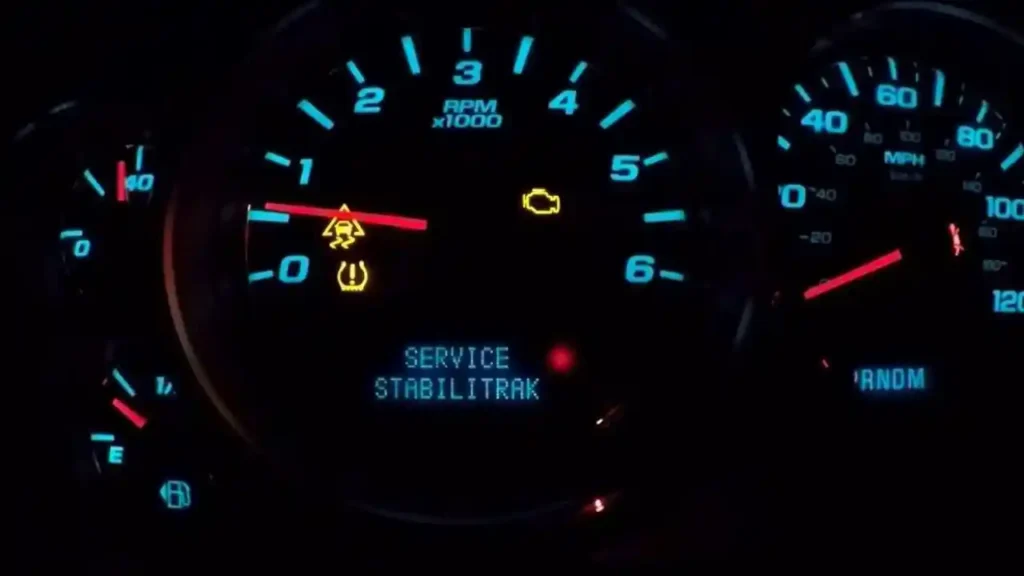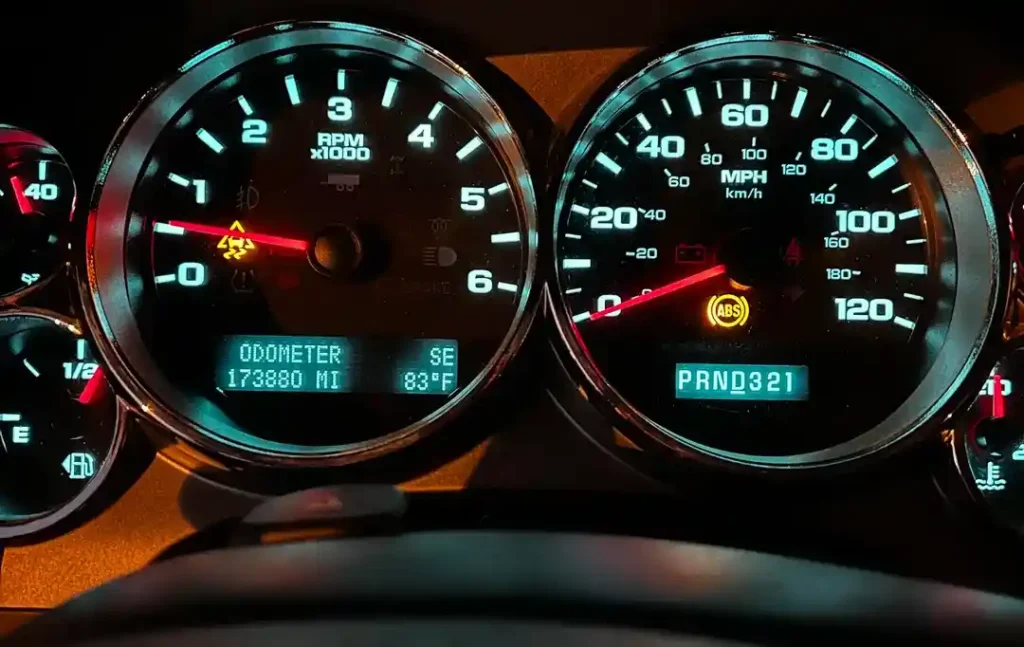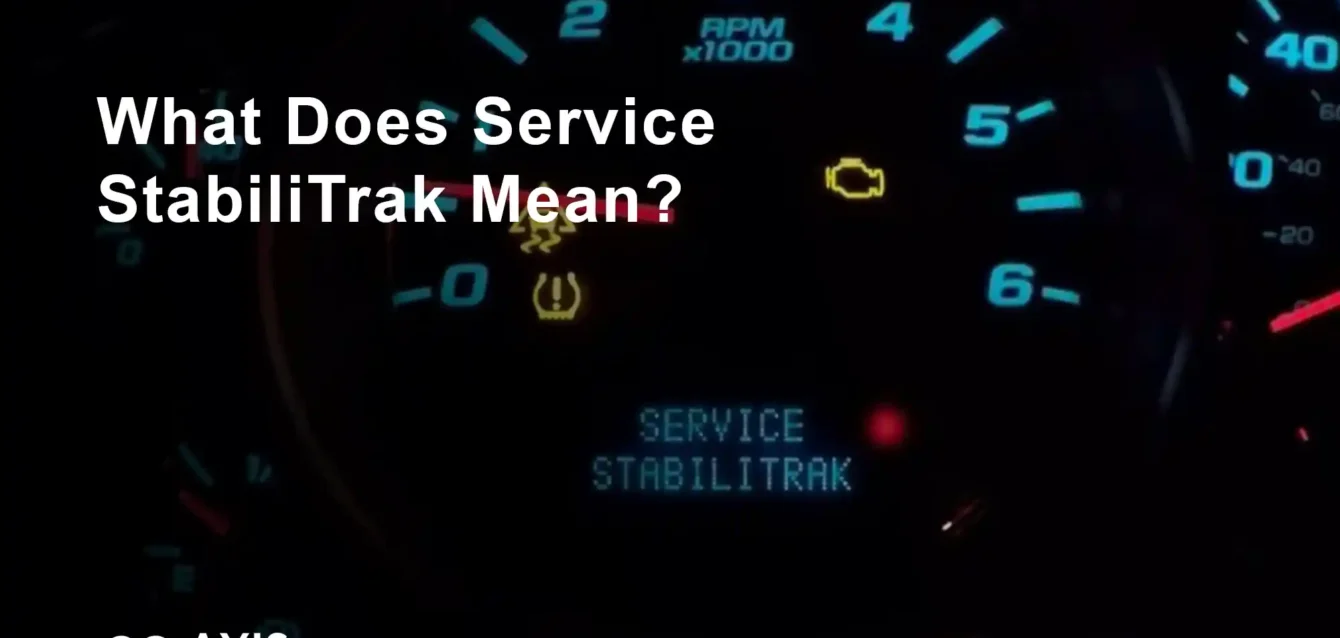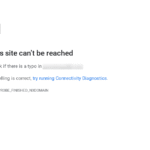StabiliTrak
You’re driving your Chevrolet, GMC, or Cadillac when suddenly the dashboard lights up with “Service StabiliTrak.” The steering feels different, and your vehicle doesn’t handle quite like it should. This warning isn’t just an annoying dashboard light but a critical alert that your vehicle’s electronic stability control system needs attention.
StabiliTrak has become one of the most important safety technologies in modern vehicles, reducing fatal single-vehicle crashes by up to 38% according to the Insurance Institute for Highway Safety. When this system malfunctions, your vehicle’s ability to maintain control in challenging conditions becomes compromised, potentially putting you and your passengers at risk.
This comprehensive guide explains everything you need to know about the Service StabiliTrak warning, from understanding how the system works to diagnosing common issues, performing DIY resets, and calculating potential repair costs. Whether you drive a Chevrolet Equinox, GMC Sierra, or Cadillac CTS, you’ll learn how to interpret this warning and take appropriate action.
What is StabiliTrak? Understanding GM’s Stability Control Technology
StabiliTrak is General Motors’ proprietary Electronic Stability Control (ESC) system, first introduced in 1996 through a partnership with Delphi Automotive. This sophisticated safety technology appears in virtually all GM vehicles, including Chevrolet, Buick, GMC, and Cadillac brands.
How StabiliTrak Works: The Technology Behind Vehicle Stability
Unlike basic traction control systems that simply prevent wheel spin, StabiliTrak provides comprehensive stability management by constantly monitoring your vehicle’s intended path versus its actual trajectory.
Core Components:
Sensor Network:
- Steering wheel position sensor tracking driver input direction
- Yaw rate sensor measuring vehicle rotation (how fast the car turns or spins)
- Lateral acceleration sensor detecting sideways G-forces
- Wheel speed sensors monitoring individual wheel rotation (one per wheel)
- Throttle position sensor tracking accelerator input
Electronic Control Unit (ECU): The StabiliTrak control module processes sensor data 25 times per second, enabling near-instantaneous response to instability. This powerful computer compares your intended direction (based on steering input) with the vehicle’s actual movement, detecting loss of control within milliseconds.
Intervention Systems:
- Selective brake application to individual wheels (can brake one wheel while leaving others unaffected)
- Engine power reduction through throttle control
- Integration with Anti-lock Braking System (ABS)
- Coordination with Traction Control System (TCS)
Real-World Operation: When StabiliTrak Activates
Scenario 1: Oversteer Correction When your vehicle’s rear end starts sliding outward during a turn (oversteer), StabiliTrak applies braking to the outside front wheel, creating a corrective yaw moment that brings the rear back in line.
Scenario 2: Understeer Prevention If the front wheels lose grip and the vehicle pushes straight instead of turning (understeer), the system brakes the inside rear wheel, helping rotate the vehicle into the turn while reducing engine power.
Scenario 3: Emergency Maneuvers During sudden lane changes or obstacle avoidance, StabiliTrak prevents the vehicle from spinning or rolling over by selectively managing brake pressure and engine output across all four wheels.
Performance Statistics:
- Response time: 20-50 milliseconds from detection to intervention
- Processing speed: 25 calculations per second
- Wheel speed monitoring: Every 10-14 milliseconds
- Brake pressure modulation: Up to 15 times per second
What Does “Service StabiliTrak” Mean? Decoding the Warning
The “Service StabiliTrak” message indicates that the Electronic Control Unit has detected a malfunction within the stability control system. When this warning appears, the system automatically disables itself (either partially or completely), leaving your vehicle without advanced stability assistance.
Different StabiliTrak Warning Messages
“Service StabiliTrak” Primary warning indicating a system malfunction requiring diagnosis and repair. The system has detected a fault and disabled stability control functions.
“StabiliTrak Off” Shows the system has been manually disabled using the dashboard button, or has automatically turned off due to a detected fault. Normal if you intentionally disabled it, concerning if it appears unexpectedly.
“StabiliTrak Not Ready” Temporary status indicating the system is initializing or recalibrating. If this message persists beyond a few seconds, it suggests calibration issues or sensor problems.
“Traction Control and StabiliTrak Off” Both stability systems are disabled simultaneously, typically indicating a shared component failure affecting multiple safety systems.
Warning: Driving Without StabiliTrak
When StabiliTrak is disabled, your vehicle operates without electronic stability intervention. While the vehicle remains drivable, you’ll experience:
- Reduced stability control, especially on slippery or uneven surfaces
- Increased risk of skidding or losing control during emergency maneuvers
- No automatic correction during oversteer or understeer situations
- Diminished traction on snow, ice, or rain-slicked roads
Can You Drive With the Warning On?
Technically yes, but with extreme caution. The vehicle will handle like older cars without stability control. Avoid:
- Aggressive steering inputs or sudden lane changes
- High-speed cornering
- Driving in adverse weather conditions (rain, snow, ice)
- Highway speeds until the system is repaired
Drive directly to a service facility or schedule mobile diagnostic service to restore this critical safety feature.
Common Causes: Why Your StabiliTrak Warning Activates
1. Faulty Wheel Speed Sensors (Most Common – 40% of Cases)
Wheel speed sensors monitor individual wheel rotation, providing critical data for StabiliTrak operation. These sensors fail frequently due to:
Causes of Failure:
- Road debris damage (rocks, gravel impact on sensor or tone ring)
- Corrosion from road salt exposure (especially in snow belt regions)
- Water intrusion into sensor connectors
- Bearing wear affecting sensor-to-tone ring gap
- Physical damage during tire service or brake work
Symptoms:
- Warning appears during specific driving conditions (turns, braking)
- Multiple warning lights illuminate simultaneously (ABS, TC, StabiliTrak)
- Occasional speedometer erratic readings
- Intermittent warning that comes and goes
Diagnosis: Scan tool shows codes C0035-C0045 (left front, right front, left rear, right rear wheel speed sensor circuit)
Repair Cost: $150-$250 per sensor (parts + labor)
2. Steering Angle Sensor Malfunction (25% of Cases)
The steering angle sensor tells StabiliTrak where you intend to go. Calibration errors or sensor failure prevent proper operation.
Causes of Failure:
- Steering system work without recalibration (alignment, rack replacement)
- Low battery voltage causing calibration loss
- Clockspring failure in steering column
- Steering wheel removal/replacement without proper procedure
- Accident damage to steering components
Symptoms:
- Warning appears during or after turns
- Steering feels normal but StabiliTrak disabled
- Warning appears immediately after starting vehicle
- Cruise control may also malfunction
Diagnosis: Codes C0710, C0460, C1223 indicate steering angle sensor issues
Repair Cost: $200-$400 including recalibration
3. Low Battery Voltage or Electrical Issues (15% of Cases)
StabiliTrak’s electronic control unit requires stable voltage. Electrical problems trigger false warnings or system shutdowns.
Causes:
- Weak or dying battery (below 12.4 volts)
- Corroded battery terminals creating voltage drops
- Faulty alternator causing charging system problems
- Poor ground connections
- Damaged wiring harness from rodent activity or collision
Symptoms:
- Multiple electrical system warnings simultaneously
- Warning appears during cold starts
- Dimming lights or sluggish starter motor
- Radio, clock, or other systems resetting frequently
Diagnosis: Battery voltage test, alternator output check, wiring inspection
Repair Cost: $100-$200 (battery replacement or wiring repair)
4. Brake System Problems (10% of Cases)
StabiliTrak relies on the braking system for intervention. Brake issues prevent proper operation.
Causes:
- Low brake fluid level (worn pads or system leak)
- Contaminated brake fluid (moisture absorption reducing effectiveness)
- Worn brake pads triggering low fluid warning
- ABS module malfunction
- Brake pedal position sensor failure
Symptoms:
- “Service Brake System” warning accompanies StabiliTrak message
- Soft or spongy brake pedal feel
- Brake warning light illuminated
- ABS activating unexpectedly or not activating when needed
Diagnosis: Brake fluid inspection, pad thickness measurement, ABS module scan
Repair Cost: $100-$800 depending on specific brake issue
5. Throttle Body or Throttle Position Sensor Issues (5% of Cases)
Engine power reduction capability requires functional throttle control. Throttle system problems disable StabiliTrak.
Causes:
- Carbon buildup on throttle body plate
- Throttle position sensor failure
- Electronic throttle control module fault
- Throttle body motor malfunction
Symptoms:
- “Reduced Engine Power” message with StabiliTrak warning
- Poor acceleration or throttle response
- Engine idling roughly or stalling
- Check Engine Light illuminated
Diagnosis: Throttle body inspection, TPS voltage test, code scan
Repair Cost: $150-$500 (cleaning to replacement)
6. Control Module Failure (5% of Cases)
The StabiliTrak control module itself can malfunction, though this is relatively rare.
Causes:
- Internal component failure from age or heat
- Water intrusion into module
- Electrical surge damage
- Software corruption
Symptoms:
- Persistent warning that can’t be reset
- Multiple system codes with no physical component failure
- Warning appears immediately after starting
Diagnosis: Advanced diagnostics showing module communication errors
Repair Cost: $500-$1,200 (module replacement and programming)
DIY Troubleshooting: How to Reset Service StabiliTrak

Before visiting a repair shop, try these simple reset procedures that resolve temporary glitches in approximately 30% of cases.
Method 1: Basic Manual Reset (5 Minutes)
Step-by-Step Process:
- Park and Prepare
- Put vehicle in Park on level ground
- Turn off engine completely
- Engage parking brake
- Steering Wheel Cycle
- Turn steering wheel fully clockwise (hard right) until it stops
- Hold for 3 seconds
- Turn steering wheel fully counterclockwise (hard left) until it stops
- Hold for 3 seconds
- Return steering wheel to center position
- Wait and Restart
- Wait 15 seconds with vehicle off
- Restart engine
- Check if warning has cleared
Success Rate: Effective for calibration glitches and minor sensor communication errors (30% of cases)
Method 2: Battery Disconnect Reset (20 Minutes)
Step-by-Step Process:
- Safety First
- Turn off vehicle and remove key
- Wait 5 minutes for electrical systems to power down
- Locate battery under hood (consult owner’s manual if needed)
- Gather tools: 10mm wrench or pliers
- Disconnect Battery
- Always disconnect negative (-) terminal first (black cable)
- Loosen terminal nut counterclockwise
- Remove cable and secure away from battery post
- Do NOT disconnect positive terminal unless necessary
- Wait Period
- Wait 10-15 minutes for vehicle computers to fully discharge
- All residual electrical charge dissipates
- This clears temporary computer memory
- Reconnect and Test
- Reconnect negative terminal securely
- Tighten nut firmly (don’t overtighten)
- Start vehicle and check for warning
Success Rate: Clears stored error codes and resets control modules (40% success for temporary faults)
Method 3: OBD-II Scanner Code Clear (10 Minutes)
Required Equipment:
- OBD-II scanner ($30-$200, available at auto parts stores)
- Bluetooth scanners work with smartphone apps (BlueDriver, Torque Pro)
Step-by-Step Process:
- Connect Scanner
- Locate OBD-II port (usually under dashboard near driver’s knees)
- Plug in scanner firmly until it clicks
- Turn ignition to “On” position (don’t start engine)
- Read Codes
- Allow scanner to connect (10-30 seconds)
- Read and record all diagnostic trouble codes (DTCs)
- Note codes starting with C (chassis), B (body), U (network)
- Common codes: C0035-C0045 (wheel sensors), C0710 (steering angle), U0073 (module communication)
- Clear Codes
- Use scanner’s “Clear Codes” function
- Confirm code clearing when prompted
- Turn off ignition, wait 10 seconds
- Test Drive
- Start vehicle and check if warning returns
- Drive for 10-15 minutes through various conditions
- If warning stays off, issue may have been temporary
- If warning returns immediately, underlying problem exists
When Reset Methods Don’t Work:
If the warning returns after reset attempts, a physical component has failed requiring repair. Persistent warnings indicate:
- Actual sensor failure (not just loose connection)
- Module malfunction requiring replacement
- Mechanical issue (damaged wiring, broken sensor mounting)
Professional diagnosis becomes necessary to identify and repair the root cause.
Professional Diagnosis and Repair: What to Expect
Diagnostic Process at Repair Shops
Initial Assessment (30-60 minutes):
- Comprehensive OBD-II scan reading all control modules
- Test drive to replicate warning conditions
- Visual inspection of sensors, wiring, connections
- Battery and charging system test
- Brake system inspection
Advanced Diagnostics (if needed):
- Individual sensor testing with multimeter
- Oscilloscope analysis of sensor signals
- Control module communication testing
- Steering angle sensor calibration check
- Wiring continuity testing
Diagnostic Fee: $50-$150 (often waived if you proceed with repairs)
Repair Cost Breakdown by Component
StabiliTrak Repair Cost by Component (2025)
| Component | Parts Cost | Labor Cost | Total Cost |
|---|---|---|---|
| Wheel Speed Sensor | $50-$120 | $80-$150 | $150-$250 |
| Steering Angle Sensor | $100-$200 | $100-$200 | $200-$400 |
| Throttle Body Cleaning | $20-$40 | $80-$120 | $100-$160 |
| Throttle Body Replacement | $200-$400 | $150-$200 | $350-$600 |
| ABS Module | $300-$800 | $150-$300 | $500-$1,100 |
| StabiliTrak Control Module | $400-$800 | $200-$400 | $700-$1,200 |
| Wiring Repair | $50-$150 | $100-$300 | $150-$450 |
Cost-Saving Strategies:
1. Get Multiple Quotes Prices vary 30-50% between dealerships, independent shops, and mobile mechanics. Call at least 3 shops.
2. Consider Aftermarket Parts Aftermarket sensors cost 40-60% less than OEM parts with similar quality. Ask about warranty coverage.
3. Check for Recalls or TSBs Some GM vehicles have Technical Service Bulletins for known StabiliTrak issues. Repairs may be covered.
4. Bundle Services If you need other maintenance (brakes, alignment), combining services often reduces labor costs.
5. Mobile Mechanic Services Mobile diagnostics and repairs eliminate shop overhead, typically saving 20-40% on labor.
Vehicle-Specific StabiliTrak Issues: Common Problems by Model
Chevrolet Equinox (2007-2017)
Most Common Issue: Wheel speed sensor failure and steering angle sensor malfunction
Typical Symptoms:
- Warning appears during turns or acceleration
- Intermittent issue that comes and goes
- Multiple warnings simultaneously (ABS, TC, StabiliTrak)
Known Problems:
- Front wheel bearing/sensor assembly fails prematurely (80,000-120,000 miles)
- Steering angle sensor loses calibration after battery replacement
- Throttle body carbon buildup causing reduced power warnings
Average Repair Cost: $200-$500
GMC Sierra / Chevrolet Silverado (2007-2016)
Most Common Issue: Throttle position sensor and wheel speed sensor problems
Typical Symptoms:
- “Reduced Engine Power” with StabiliTrak warning
- Warning appears during wet conditions
- Temporary loss of power when accelerating
Known Problems:
- Throttle body requires periodic cleaning (every 60,000 miles)
- Rear wheel speed sensors corrode from road salt
- Brake pedal position sensor causes false warnings
Average Repair Cost: $150-$600
Cadillac CTS (2008-2015)
Most Common Issue: Steering angle sensor and yaw rate sensor malfunctions
Typical Symptoms:
- Sudden power loss during turns
- Jerky acceleration after sharp maneuvers
- Warning appears after steering wheel movements
Known Problems:
- Multi-axis acceleration sensor module failure (under passenger seat)
- Software updates required for certain model years
- Clockspring failure in steering column
Average Repair Cost: $300-$800
Chevrolet Traverse / GMC Acadia (2009-2017)
Most Common Issue: Brake fluid level sensor and wheel speed sensors
Typical Symptoms:
- Warning accompanies “Service Brake System” message
- Issues appear with low brake fluid
- Tire size mismatch triggering warnings
Known Problems:
- All four tires must be identical (same brand, model, size)
- Brake pad wear causing low fluid warnings
- Sensor contamination from brake dust
Average Repair Cost: $100-$400
Prevention Tips: Keeping Your StabiliTrak System Healthy

Regular Maintenance Schedule
Every Oil Change (3,000-5,000 miles):
- Visual inspection of wheel speed sensor wiring
- Check for loose connections or visible damage
- Verify tire pressure matches specifications (mismatched pressure affects sensors)
Every 30,000 Miles:
- Professional brake system inspection
- Brake fluid condition check (should be clear, not dark)
- Steering system alignment check
- Battery load test
Every 60,000 Miles:
- Throttle body cleaning (prevent carbon buildup)
- Comprehensive electrical system inspection
- Wheel bearing inspection (worn bearings affect sensors)
Best Practices for Longevity
Tire Management:
- All four tires must be same size, brand, and tread depth
- Mismatched tires confuse wheel speed sensors
- Rotate tires every 5,000-7,000 miles
- Replace all four tires simultaneously when possible
Battery Care:
- Replace battery every 4-5 years preventatively
- Clean battery terminals annually
- Test battery before winter season
- Weak batteries cause false StabiliTrak warnings
Driving Habits:
- Avoid deep water crossings that submerge wheel sensors
- Gentle driving through deep snow (packed snow damages sensors)
- Promptly repair minor accidents affecting front end
- Address brake warnings immediately
Winter Precautions:
- Remove ice/snow buildup in wheel wells (can affect sensors)
- Apply dielectric grease to sensor connectors (prevents corrosion)
- Use quality winter tires (don’t mix types)
Frequently Asked Questions
Can I Drive With Service StabiliTrak Warning?
Yes, you can drive with the warning illuminated, but exercise extreme caution. When StabiliTrak is disabled, your vehicle loses electronic stability control, meaning reduced ability to prevent skids or maintain control during emergency maneuvers. Drive at moderate speeds, avoid aggressive steering inputs, and schedule service promptly. In adverse weather (rain, snow, ice), avoid driving entirely until the system is repaired. The vehicle will handle like older cars without stability control, requiring more careful driving technique.
How Much Does StabiliTrak Repair Cost?
StabiliTrak repair costs range from $80-$1,200 depending on the underlying issue. Simple fixes like cleaning connectors or topping off brake fluid cost $50-$100. Wheel speed sensor replacement typically runs $150-$250 per sensor. Steering angle sensor calibration costs $100-$200, while replacement runs $200-$400. Major repairs like ABS module or StabiliTrak control module replacement can reach $500-$1,200. Most common issues (sensor failures) fall in the $150-$400 range. Diagnostic fees add $50-$150 but are often waived if you proceed with repairs at the same facility.
What’s the Difference Between StabiliTrak and Traction Control?
Traction Control prevents wheel spin during acceleration by reducing engine power and applying brakes to spinning wheels, primarily helping during launch and acceleration on slippery surfaces. StabiliTrak is a comprehensive stability control system that includes traction control but adds directional stability management. While traction control only monitors wheel spin, StabiliTrak monitors steering input, yaw rate, and lateral acceleration to detect when the vehicle is not following the driver’s intended path. StabiliTrak can intervene during cornering, emergency maneuvers, and any situation where the vehicle becomes unstable, not just during acceleration. Think of traction control as a subset of StabiliTrak’s broader capabilities.
Will StabiliTrak Warning Fail Vehicle Inspection?
This depends on your state’s inspection requirements. In states with comprehensive safety inspections (like New York, Pennsylvania, Virginia), an illuminated StabiliTrak warning typically results in inspection failure because it indicates a malfunctioning safety system. However, in states with emissions-only testing or no inspections, the warning won’t prevent registration renewal. Even if your state doesn’t require it, addressing the warning remains important for safety reasons. Check your specific state’s DMV requirements, but plan to repair the system before scheduled inspections in states with safety checks.
Can Low Tire Pressure Cause StabiliTrak Warning?
Yes, significantly low tire pressure or mismatched tire pressures can trigger StabiliTrak warnings. The system monitors individual wheel speeds, and underinflated tires rotate at different speeds than properly inflated ones, causing the system to detect apparent wheel slip. Additionally, mixing tire sizes, brands, or tread patterns creates rolling circumference differences that confuse wheel speed sensors. If your StabiliTrak warning appears after getting new tires or you’ve noticed low tire pressure, check and adjust all four tires to manufacturer specifications (found on driver’s door jamb sticker). If the warning persists after proper inflation, other issues exist requiring diagnosis.
Does StabiliTrak Use More Gas?
No, StabiliTrak does not measurably affect fuel economy during normal driving. The system only activates when it detects loss of traction or stability, momentarily reducing engine power or applying selective braking. During these brief interventions (typically 1-2 seconds), fuel consumption may temporarily decrease due to power reduction. However, these events are infrequent enough that they don’t impact overall fuel economy. The monitoring systems run continuously but draw minimal electrical power from the alternator. In fact, StabiliTrak can improve fuel efficiency by helping maintain optimal vehicle control, preventing wheel spin that wastes fuel, and enabling more confident, efficient driving in challenging conditions.
Can I Turn Off StabiliTrak Permanently?
Most GM vehicles allow temporary StabiliTrak disabling by pressing and holding the StabiliTrak button (usually near shift lever) for 5-7 seconds. However, the system automatically re-enables when you restart the vehicle for safety reasons. You cannot permanently disable StabiliTrak in modern GM vehicles without aftermarket modifications or computer reprogramming, which would be unsafe and potentially illegal in some jurisdictions. The system is designed to operate continuously because it significantly enhances safety. The temporary disable function exists for specific situations (rocking vehicle out of mud/snow, dyno testing) but should not be used during normal driving. If the system is malfunctioning and you need to disable it temporarily until repairs can be made, you can disconnect specific fuses, but this also disables related safety systems.
Why Does My StabiliTrak Warning Come and Go?
Intermittent StabiliTrak warnings typically indicate loose connections, marginal sensor operation, or temperature-sensitive failures. Common causes of intermittent warnings include loose wheel speed sensor connectors that make inconsistent contact (especially over bumps), corroded wiring that temporarily loses continuity, sensors operating at the edge of failure that work when cold but fail when hot, or low battery voltage causing the system to shut down under electrical load. The warning might appear during specific conditions (hard turns, wet weather, cold starts) when the marginal component reaches its failure threshold. Intermittent issues are more challenging to diagnose but often worsen over time, becoming permanent failures. If you experience intermittent warnings, schedule diagnosis during a period when the warning is active if possible, or at minimum record the specific conditions when it appears to help technicians replicate the problem.
Conclusion: Taking Action on Your StabiliTrak Warning
The “Service StabiliTrak” warning demands attention but doesn’t necessarily indicate catastrophic failure or immediate danger. Understanding what triggers this warning, knowing how to perform basic troubleshooting, and recognizing when professional repair becomes necessary empowers you to make informed decisions about your vehicle’s safety systems.
Key takeaways:
Immediate Actions:
- Try manual reset procedures before assuming expensive repairs
- Check tire pressure and ensure all tires match
- Inspect for obvious issues (loose connectors, low brake fluid)
- Drive cautiously until system is repaired
When to Seek Professional Help:
- Warning persists after reset attempts
- Multiple warning lights illuminate simultaneously
- Vehicle exhibits handling changes or power reduction
- Warning appears immediately after starting
Cost Expectations:
- Most repairs fall in the $150-$400 range
- Simple issues (sensors, cleaning) cost less
- Complex problems (modules) cost more
- Get multiple quotes to ensure fair pricing
StabiliTrak represents a significant safety advancement, reducing crash risk by 38% in equipped vehicles. While the warning can be alarming, systematic troubleshooting and appropriate repair quickly restore this critical safety feature. Don’t ignore the warning, but don’t panic either. Follow the diagnostic steps outlined in this guide, and you’ll be back to safe, confident driving in no time.





